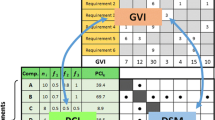Abstract
To meet the increasingly heterogeneous market, a product family strategy is needed to determine how customized variants can be derived from a common product platform within acceptable cost and time. Toward this, a suitably conceived and developed product family architecture (PFA) is important for implementing mass customization. In this paper, we present a systematic approach to modularize PFA at the early design phase, which is the conceptual design stage. The PFA can be viewed as a conceptual structure with the following three interrelated elements: module, variant, and coupling interface. Identifying variant as the external driver of architectural variation, this paper develops a variety index (VI) method to estimate effects of customization on the conceptual modules. Rather than just identification of module boundary in the product architecture, the proposed modularization method translates the variety source generated from requirements analysis into a dynamic configuration of the conceptual PFA, involving variety analysis, product modularization, and generation of product portfolio architecture. An example of a power tool design is used to demonstrate the proposed method.
Similar content being viewed by others
Abbreviations
- AMM:
-
attribute module matrix
- NRE:
-
nonrecurring engineering
- PBPF:
-
platform-based product family
- PFA:
-
product family architecture
- PPA:
-
product portfolio architecture
- PPP:
-
product portfolio planning
- QFD:
-
quality function deployment
- VI:
-
variety index
References
Jiao JX, Tseng MM (1999) A method of developing product family architecture for mass customization. J Intel Manuf 10:3–20
Silveira GD, Borenstein D, Fogliatto FS (2001) Mass customization: literature review and research directions. Int J Prod Econ 72:1–13
Meyer M, Lehnerd A (1997) The power of product platforms, building value and cost leadership. Free Press, New York
Simpson TW (2004) Product platform design and customization: status and promise. Artif Intell Eng Des Anal Manuf 18:3–20
Jose A, Tollenaere M (2005) Modular and platform methods for product family design: literature analysis. J Intell Manuf 16:371–390
Jiao JX, Tseng MM (2004) Customizability analysis in design for mass customization. Comput Aided Des 36:745–757
Ulrich K (1995) The role of product architecture in the manufacturing firm. Res Policy 24:419–440
Ulrich K, Eppinger SD (2000) Product design and development. McGraw-Hill, Boston
Gershenson JK, Prasad GJ, Zhang Y (2003) Product modularity: definitions and benefits. J Eng Des 14(3):295–313
Mikkola JH, Gassmann O (2003) Managing modularity of product architectures: toward an integrated theory. IEEE Trans Eng Manage 50(2):204–218
Van Wie MJ, Greer JL, Matthew IC, Stone RB, Wood KL (2001) Interfaces and product architecture. ASME, Conf Proc DETC2001, Pittsburgh, PA, USA
Van Wie MJ, Rajan P et al (2003) Representing product architecture. ASME, Conf Proc DETC2003, Chicago, IL, USA
Holtta KM, Otto KN (2005) Incorporating design effort complexity measures in product architectural design and assessment. Des Stud 26:463–485
Fixson K (2005) Product architecture assessment: a tool to link product, process and supply chain design decisions. J Oper Manag 23:345–369
Martin MV, Ishii K (2002) Design for variety: developing standardized and modularized product family architectures. Res Eng Des 13:213–235
Moore WL, Louviere JJ, Verma R (1999) Using conjoint analysis to help design product platforms. J Prod Innov Manag 16:27–39
Fujita K, Yoshida H (2004) Product variety optimization simultaneously designing module combination and module attributes. Concurr Eng: Res Appl 12(2):105–118
Simpson TW, Jonathan RA, Farrokh M (2001) Product platform design: method and application. Res Eng Des 13:2–22
Du XH, Jiao JX, Tseng MM (2001) Architecture of product family: fundamentals and methodology. Concurr Eng: Res Appl 9(4):309–325
Erens F, Verhulst K (1997) Architectures for product families. Comput Ind 33:165–178
Muffatto M, Roveda M (2002) Product architecture and platforms: a conceptual framework. Int J Technol Manag 24(1):1–16
Hsiao SW, Liu E (2005) A structural component-based approach for designing product family. Comput Ind 56:13–28
Jiao JX, Tseng MM (2000) Fundamentals of product family architecture. Integr Manuf Syst 11(7):469–483
Chen KM, Liu RJ (2005) Interface strategies in modular product innovation. Technovation 25:771–782
Suh NP (2001) Axiomatic Design: Advances and Application. Oxford University Press, New York
Pullman ME, Moore WL, Wardell DG (2002) A comparison of quality function deployment and conjoint analysis in new product design. J Prod Innov Manag 19:354–364
Jiao JX, Zhang YY, Wang Y (2005) Product portfolio planning with customer-engineering interaction. IIE Trans 37(9):801–814
Jiao JX, Zhang YY, Wang Y (in press) A heuristic genetic algorithm for product portfolio planning. Comput Oper Res
Gonzalez-Zugasti JP, Otto KN, Baker JD (2000) A method for architecture product platforms. Res Eng Des 12:61–72
Weck OL, Suh ES, Chang D (2003) Product family and platform portfolio optimization. ASME, Conf Proc DETC2003, Chicago, IL, USA
Pahl G, Beitz W (1996) Engineering design: A systematic approach. Design Council, London
Stone R, Wood K (2000) Development of a functional basis for design. J Mech Des 122(4):359–370
Krishnan V, Gupta S (2001) Appropriateness and impact of platform-based product development. Manage Sci 47(1):52–68
Yu JS, Gonzalez-Zugasti JP, Otto KN (1999) Product architecture definition based upon customer demands. J Mech Des 121(3):329–335
Dahmus JB, Gonzalez-Zugasti JP, Otto KN (2001) Modular product architecture. Des Stud 22:409–424
Kurtadikar RM, Stone RB, Van Wie MJ, McAdams DA (2004) A customer needs motivated conceptual design methodology for product portfolios. ASME2004, Conf Proc DETC, Salt Lake City, UT, USA
Newcomb PJ, Bras B, Rosen DW (1998) Implications of modularity on product design for life cycle. J Mech Des 120:483–490
Gershenson JK, Prasad GJ, Allamneni S (1999) Modular product design: a life-cycle view. J Integr Des Process Sci 3(4):13–26
Stone R, Wood K, Crawford R (2000) A heuristic method for identifying modules for product architectures. Des Stud 21:5–31
Author information
Authors and Affiliations
Corresponding author
Rights and permissions
About this article
Cite this article
Zhuo, L., Yoke San, W. & Kim Seng, L. Integrated approach to modularize the conceptual product family architecture. Int J Adv Manuf Technol 36, 83–96 (2008). https://doi.org/10.1007/s00170-006-0805-y
Received:
Accepted:
Published:
Issue Date:
DOI: https://doi.org/10.1007/s00170-006-0805-y




